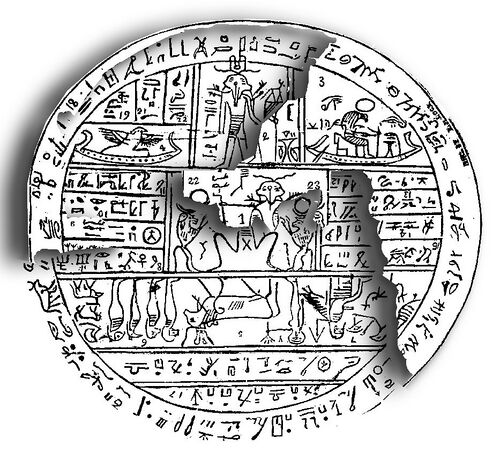
FAIR is a non-profit organization dedicated to providing well-documented answers to criticisms of the doctrine, practice, and history of The Church of Jesus Christ of Latter-day Saints.
No edit summary |
No edit summary |
||
| Line 1: | Line 1: | ||
{{Articles FAIR copyright}} {{Articles Header 1}} {{Articles Header 2}} {{Articles Header 3}} {{Articles Header 4}} {{Articles Header 5}} {{Articles Header 6}} {{Articles Header 7}} {{Articles Header 8}} {{Articles Header 9}} {{Articles Header 10}} | {{Articles FAIR copyright}} {{Articles Header 1}} {{Articles Header 2}} {{Articles Header 3}} {{Articles Header 4}} {{Articles Header 5}} {{Articles Header 6}} {{Articles Header 7}} {{Articles Header 8}} {{Articles Header 9}} {{Articles Header 10}} | ||
{{Resource Title|Book of Abraham Facsimile 2: The hypocephalus}} | {{Resource Title|Book of Abraham Facsimile 2: The hypocephalus}} | ||
The illustration represented by Facsimile 2 ([http://scriptures.lds.org/en/abr/fac_2 view]) is a ''hypocephalus'', a disc made of linen, papyrus, or bronze, covered with inscriptions and images which relate to one of the last spells in the Book of the Dead. The disc was placed under the head (''hypocephalus'' = Greek: "under the head") of the deceased in the belief that the spell would cause the head and body to be enveloped in flames or radiance, making the deceased divine. Joseph Smith's notes to Facsimile 2 identify several figures as representing God sitting in the heavens among the stars and others of his creations. | The illustration represented by Facsimile 2 ([http://scriptures.lds.org/en/abr/fac_2 view]) is a ''hypocephalus'', a disc made of linen, papyrus, or bronze, covered with inscriptions and images which relate to one of the last spells in the Book of the Dead. The disc was placed under the head (''hypocephalus'' = Greek: "under the head") of the deceased in the belief that the spell would cause the head and body to be enveloped in flames or radiance, making the deceased divine. Joseph Smith's notes to Facsimile 2 identify several figures as representing God sitting in the heavens among the stars and others of his creations. | ||
Criticisms related to Facsimile 2 are related to Joseph Smith's explanations of the individual elements. | Criticisms related to Facsimile 2 are related to Joseph Smith's explanations of the individual elements. | ||
<onlyinclude> | <onlyinclude> | ||
{{SummaryItem | {{SummaryItem | ||
| Line 43: | Line 38: | ||
{{Articles Footer 1}} {{Articles Footer 2}} {{Articles Footer 3}} {{Articles Footer 4}} {{Articles Footer 5}} {{Articles Footer 6}} {{Articles Footer 7}} {{Articles Footer 8}} {{Articles Footer 9}} {{Articles Footer 10}} | {{Articles Footer 1}} {{Articles Footer 2}} {{Articles Footer 3}} {{Articles Footer 4}} {{Articles Footer 5}} {{Articles Footer 6}} {{Articles Footer 7}} {{Articles Footer 8}} {{Articles Footer 9}} {{Articles Footer 10}} | ||
<!-- PLEASE DO NOT REMOVE ANYTHING BELOW THIS LINE --> | |||
[[en:Book of Abraham/Joseph Smith Papyri/Facsimiles/Facsimile 2]] | |||
[[es:El Libro de Abraham/Papiros de José Smith/Facsímiles/Facsímil 2]] | [[es:El Libro de Abraham/Papiros de José Smith/Facsímiles/Facsímil 2]] | ||
[[pt:O Livro de Abraão/Joseph Smith Papiros/Fac-símiles/Fac-símile 2]] | [[pt:O Livro de Abraão/Joseph Smith Papiros/Fac-símiles/Fac-símile 2]] | ||
The illustration represented by Facsimile 2 (view) is a hypocephalus, a disc made of linen, papyrus, or bronze, covered with inscriptions and images which relate to one of the last spells in the Book of the Dead. The disc was placed under the head (hypocephalus = Greek: "under the head") of the deceased in the belief that the spell would cause the head and body to be enveloped in flames or radiance, making the deceased divine. Joseph Smith's notes to Facsimile 2 identify several figures as representing God sitting in the heavens among the stars and others of his creations.
Criticisms related to Facsimile 2 are related to Joseph Smith's explanations of the individual elements.



FAIR is a non-profit organization dedicated to providing well-documented answers to criticisms of the doctrine, practice, and history of The Church of Jesus Christ of Latter-day Saints.
We are a volunteer organization. We invite you to give back.
Donate Now